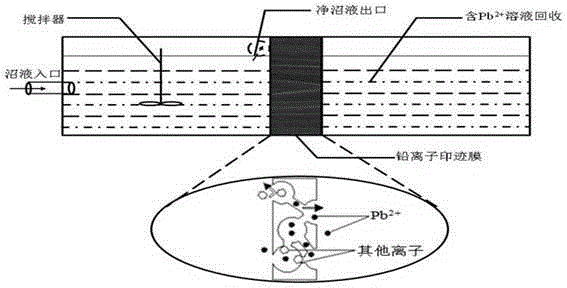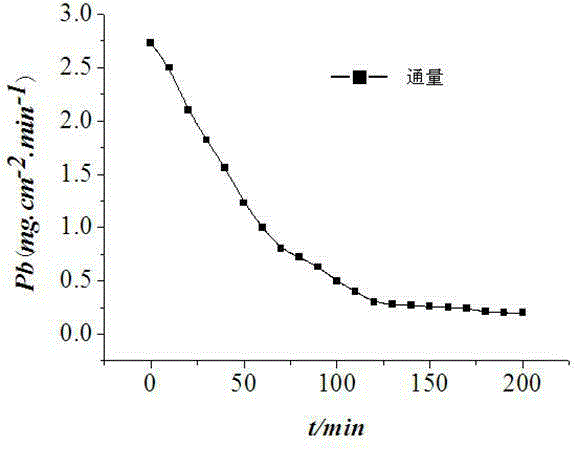A method for separating and enriching Pb2+ in biogas slurry by using lead ion imprinted membrane
A technology for separation and enrichment of lead ions, applied in semi-permeable membrane separation, chemical instruments and methods, membrane technology, etc., can solve the problems of non-recyclable heavy metals, complicated process, secondary pollution, etc., and achieve labor cost saving and operation Simple, easy-to-maintain effects
- Summary
- Abstract
- Description
- Claims
- Application Information
AI Technical Summary
Problems solved by technology
Method used
Image
Examples
Embodiment 1
[0027] The preparation of embodiment 1 lead ion imprinted membrane
[0028] With dibenzo-18-crown-6 as porogen, Pb(NO 3 ) 2 As the template molecule, the lead ion imprinted membrane was prepared with sodium carboxymethylcellulose (CMC) as the substrate; figure 2 Electron scanning electron micrograph of lead ion imprinted membrane; CMC does not add porogen dibenzo-18-crown ether-6 and template molecule Pb(NO 3 ) 2 When , the membrane has a compact structure (a); when the porogen dibenzo-18-crown-6 and the template molecule Pb(NO 3 ) 2 When the viscosity of the system decreases, the diffusion speed of the solvent is accelerated to form a loose (figure b) and ravine-like membrane structure (figure c), and the radius of the hole is about 0.130~0.170nm. Since the template molecule Pb(NO) in the lead ion imprinted membrane 3 ) 2 Self-assembly with the porogen dibenzo-18-crown-6, the inner cavity is formed according to the imprinted ion Pb 2+ The size and shape of the format...
Embodiment 2
[0039] Example 2 Experimental analysis of the removal effect of heavy metal Pb in the anaerobic digestion solution of livestock and poultry breeding sewage
[0040] The experiment was carried out at 298K, the lead ion imprinted membrane was used as the diaphragm between the two electrolytic cells, the left chamber was the pretreated anaerobic digested biogas slurry, and the right chamber was 0.01mol L -1 lead-containing solution, the volume of the solution in the two electrolytic cells is 100mL, and the effective membrane area of the lead ion imprinted membrane is 10cm 2 , take the biogas fluid of the left ventricle every 10 minutes of infiltration (the liquid volume is 5mL), take a total of 5 times, and measure the heavy metal Pb in the left ventricle respectively 2+ The content is shown in Table 3.
[0041] Table 3 The small-scale test data of the imprinted membrane on the heavy metal Pb imprinting effect in the anaerobic digestion stock solution
[0042]
[0043] (No...
Embodiment 3
[0045] The lead ion imprinted membrane after the cleaning of embodiment 3 is to Pb in the anaerobic digestion liquid 2+ Pilot test analysis of imprinting effect
[0046] The experiment was carried out at 298K, and the lead ion imprinted membrane after chemical cleaning was used as the diaphragm between the two pools. The left pool was taken from pretreated biogas slurry from different farms, and the right pool was 0.01mol· L -1 lead-containing solution, the solution volume in the two pools is 100m 3 , the effective membrane area of the lead ion imprinted membrane is 7m 2 , take the biogas slurry from the left pond every 10 minutes (the volume of liquid taken is 5mL), take a total of 5 times, and measure the heavy metal Pb in the left pond respectively 2+ The data are shown in Table 4. The schematic diagram of the separation operation of lead ion imprinted membrane is as follows: figure 1 shown.
[0047] Table 4 Effect of lead ion imprinted membrane on Pb in anaerobi...
PUM
| Property | Measurement | Unit |
|---|---|---|
| pore size | aaaaa | aaaaa |
Abstract
Description
Claims
Application Information
 Login to View More
Login to View More - R&D
- Intellectual Property
- Life Sciences
- Materials
- Tech Scout
- Unparalleled Data Quality
- Higher Quality Content
- 60% Fewer Hallucinations
Browse by: Latest US Patents, China's latest patents, Technical Efficacy Thesaurus, Application Domain, Technology Topic, Popular Technical Reports.
© 2025 PatSnap. All rights reserved.Legal|Privacy policy|Modern Slavery Act Transparency Statement|Sitemap|About US| Contact US: help@patsnap.com



